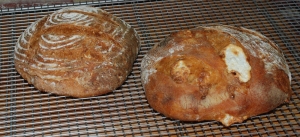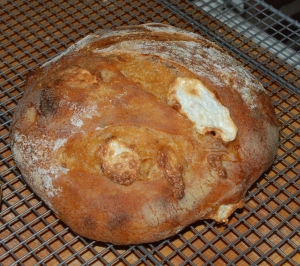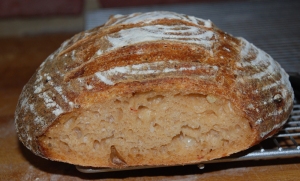 I was in a creative mood the other day and decided to try something different. I have made semolina bread before but this time I decided to convert the starter over to a semolina based concoction along with a little whole wheat flour as well. My wife had bought a nice ball of fresh mozzarella so I figured why not incorporate some cheese and throw in some roasted peppers and roasted potatoes as well.
I was in a creative mood the other day and decided to try something different. I have made semolina bread before but this time I decided to convert the starter over to a semolina based concoction along with a little whole wheat flour as well. My wife had bought a nice ball of fresh mozzarella so I figured why not incorporate some cheese and throw in some roasted peppers and roasted potatoes as well.
The dough ended up very wet due to the roasted red peppers I used from a jar had a very high water content, so you may choose to add some additional flour as you are preparing the final dough.
The final bread came out excellent with a nice reddish tint and a great open and crispy crumb. You could really taste the roasted peppers and the dough had an excellent sour tang. The only thing I would change would be to fold the cheese in before shaping the final dough rather than before putting it in the fridge for its overnight rest.
Starter
3.7 ounces White Starter, 68% hydration
8 ounces Extra Fancy Durum Semolina Flour (do not use the course grade)
2.5 ounces Whole Wheat Flour
8 ounces Water (room temperature)
Final Dough
16 oz. Starter from above (you will have extra starter so you need to weigh this)
11 oz. Water (90 degrees F)
13 ounces French Style Flour (from King Arthur Flour-this has a 11.5% Protein level but if you don't have you can substitute with All Purpose Flour)
5 ounces Extra Fancy Durum Semolina Flour
2 1/2 Tsp. Salt (sea salt or table salt)
1.6 oz. Roasted Red Peppers
6.2 oz. Fresh Mozzarella
5 oz. Potatoes (I had some left-over roasted potatoes, but you can use left over mashed potatoes or make some fresh or use the equivalent instant potato flakes)
Directions
Make the Starter by adding the water to your existing starter amount and mix for a minute to break it up. Add the flours and mix for 1 to 2 minutes until thoroughly mixed. Put in a lightly oiled bowl and loosely cover. Keep at room temperature for 5-6 hours until the starter becomes bubbly and doubles in size (I usually do this the night before and let it sit overnight). You can either use the starter right away, or cover tightly and refrigerate until ready to use. If you don't plan on using it that day, you will have to refresh the new starter before using in the final dough.
For the final dough, using your stand mixer or by hand, mix the water with the new starter to break it up.
Add the flour, potatoes, salt, red peppers (chop them up into small pieces) and mix on the lowest speed for 2 minutes. Let rest for 5 minutes.
Mix for 4 minutes more on medium speed, adding more flour if necessary to produce a slightly sticky ball of dough.
Remove dough to your lightly floured work surface and need for 1 minute and form into a ball. Flatten into a rectangle and add the cheese and form dough into a ball. (You can also skip this part and add the cheese when you are ready to form the final loaves.)
Leave uncovered for 15 minutes.
Do a stretch and fold and form into a ball again and cover with a clean moist cloth or oiled plastic wrap.
After another 10 minutes do another stretch and fold and let it rest again for another 10 - 15 minutes. Do one last stretch and fold and then put it into a lightly oiled bowl that has enough room so the dough can double overnight.
Let the dough sit in your bowl for 2 hours at room temperature. It should only rise slightly at this point. After the 2 hours are up put in your refrigerator for at least 12 hours or up to 3 days.
When ready to bake the bread take your bowl out of the refrigerator and let it sit at room temperature for around 2 hours. After 2 hours shape the dough as desired being careful not to handle the dough too roughly so you don't de-gas it.
Place it in your bowl, banneton or shape into baguettes.
Let it sit at room temperature for 2 hours covered with oiled plastic wrap or a moist cloth.
Pre-heat oven with baking stone (I use one on bottom and one on top shelf of my oven), to 500 degrees F.
Slash loaves as desired and place empty pan in bottom shelf of oven.
Pour 1 cup of very hot water into pan and place loaves into oven.
Lower oven to 450 Degrees and bake for 25 - 35 minutes until bread is golden brown and internal temperature reaches 200 degrees.
Shut the oven off and leave the bread inside with the door slightly open for 10 minutes. This will help dry the loaves out and keep the crust crunchy.
Let cool on cooling rack and enjoy!
This post has been submitted to the Yeast Spotting Site here: http://www.wildyeastblog.com/category/yeastspotting
Please visit my other blog at www.mookielovesbread.wordpress.com for some of my older recipes.

